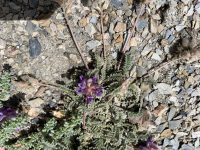|
Oxytropis tatarica Baker (syn: Oxytropis tatarica Boiss.);
.
.
WILD FLOWERS FROM THE HIGH-ALTITUDE BATTLE ZONES OF THE MASHKOH-DRASS-BATALIK LOC SECTORS : (mixed thread): 1 correct image. Could the members of this esteemed group assist in a brief description and possibly ID of these wild flowers I photographed while climbing with Indian Army expeditions to 15000 feet and above to commemorate the 20 years of the Kargil War. How do these flowers survive in the conditions peculiar to these sectors?
And any other general comment on these flowers from the battlefields of Tololing, Khalubar, Bhimbet nallah etc. Attachments (4)- 273 kb, 1 mb, 2 mb & 2 mb.
Please post individual sp. separately along with date like elevation, date, location, habitat image
and all aspects of the sp.
My requirement at the moment is very limited as I am a news journalist. I shall seek detailed answers later on each species. I have indicated the general, contiguous areas and altitudes where I found these flowers. My focus is to explain the war by referring to the flowers found in each of the battlezones. 1. Check for Oxytropis spp. Occurring in that area. 2. Hooker’s Iris (Iris hookeriana) 3. Clustered Rhodiola (Rhodiola fastigiata) 4. Can be Alpine aster (Aster flaccidus) I think … is right. It could be Oxytropis tatarica Baker, similar plant O. willamsii, formerly under O. tatarica is distributed in Nepal. Associated leaves below belong to different plant.
ID Request- Oxytropis Herb at Changla Pass -Ladakh – Sept- PKA-01 : 6 posts by 2 authors. Attachments (7)
Seen this Oxytropis sp. (Herb) enroute Changla Pass, ladakh.
(Atitude: 17000 ft approx). Family: Fabaceae… Date/Time: 21-06-2016 / 11:40am.. Pl. check with Oxytropis pusilla as per images in FOI. As mentioned for a previous inquiry, Oxytropis is a large genus; some of the species in Ladakh are difficult to identify/distinguish.
One has to inspect Oxytropis carefully, as Stewart lists 10 species from Ladakh, whilst Klimes & Dickore have 14 in their more up-todate checklist incl. a hybrid between O.microphylla and O.chiliophylla! It is a very large genus indeed.
Sometimes not easy to distinguish between Oxytropis and Astragalus.
I do not initially have any suggestions which species … photographed at Chang La.
Hopefully, others can help? Oxytropis densa Benth. ex Bunge ??
Thanks … Oxytropis tatarica is also one of the sp. reported from this region. That is another possibility …! More likely to be Oxytropis tatarica as per images and details herein and as per GBIF
Looks different from Oxytropis densa Benth. ex Bunge as per GBIF. .
Could manage a single pic.
Could you please validate if this is also Oxytropis microphylla?
To me, this appears similar to images at Pl. check.
. References: Catalogue of Life The Plant List Ver.1.1 ILDIS POWO GBIF (with specimens) Flora of Pakistan gardenbreizh Research Gate (with images) A new species of Oxytropis (Fabaceae: Papilionoideae) from India– Phytotaxa 155(1):50-58 · December 2013 (A new species Oxytropis sanjappae is described and illustrated from the Himalaya in India. The new species is widely scattered from Losar to Kaza in Lahul-Spiti region of Himachal Pradesh State. The relationship of the species has been discussed with O. cachemiriana and O. tatarica. The new species differs in having hairs very dense, silky and white, stems generally absent or quite reduced, racemes capitate, globose-ovoid or oblong, many-flowered, dense and elongating in infruitescence, calyx teeth distinctly longer than tube, corolla light purplish pink and almost equal to calyx, wing petals obtuse at apex, mucro of the keel petal ca. 1 mm long and pods comparatively larger in size. A taxonomic key to the all 18 species of the genus occurring in India including new ones has been provided for the first time. In addition, the ecological studies related with the frequency, density, basal cover and importance value index (IVI) have also been carried out to know the conservation status of the species in the Himalaya.)
|
Disclaimer
1. For any mistake in identification or for becoming efloraofindia e-group member (for contributing towards building of efloraofindia or otherwise), pl. mail to indiantreepix@googlegroups.com or itpmods@googlegroups.com
2. For better viewing of species’ pages, colour scheme & formatting is being followed as: Description of the species, Details of other flora species on the same page, Uses/ harms, Distribution, Abundance/ Location/ Flowering time & date, Habit & habitat, Etymology & pronunciation, Other interesting information, stories etc., Others, Botanical names, Common names, Main point of discussion below, Discussion about Botanical names.
Navigation
- Award for eFloraofIndia
- Colour scheme & formatting
- Copyrights, Permissions, Citations
- eFloraofIndia appreciated
- Names of Plants in India site
- Flowersofindia site
- Posting Guidelines
- For members’ information
- Logo, Tagline, Acronym
- Volunteers required
- ‘Pitamah’ of eFloraofIndia
- ‘अजेय’ ‘Ajey’ of eFloraofIndia
- ‘Saarthi’ ‘सारथि’ of eFloraofIndia
- ‘Jewel’ of eFloraofIndia
- ‘Grassman’ of eFloraofIndia

